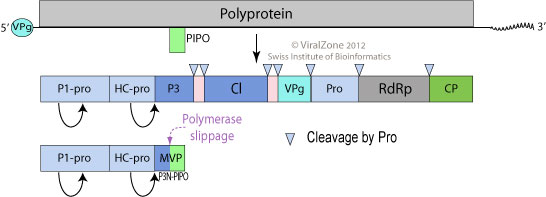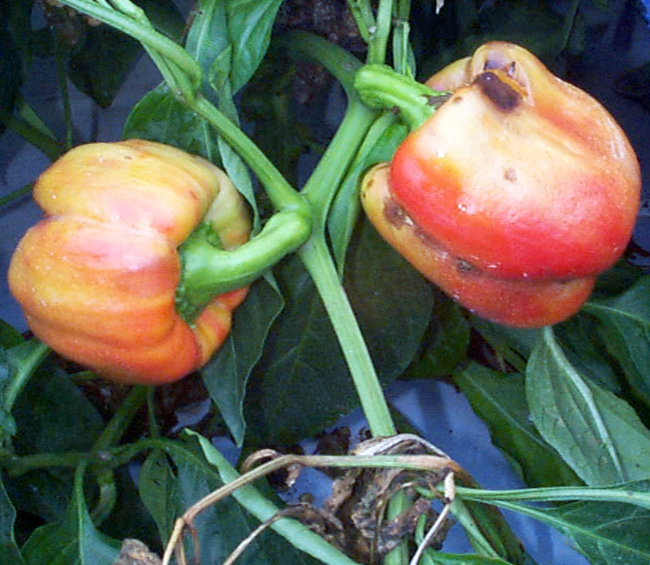|
Potyviridae
''Potyviridae'' is a family of positive-strand RNA viruses that encompasses more than 30% of known plant viruses, many of which are of great agricultural significance. The family has 12 genera and 235 species, three of which are unassigned to a genus. Structure Potyvirid virions are nonenveloped, flexuous filamentous, rod-shaped particles. The diameter is around 12–15 nm, with a length of 200–300 nm. Genome Genomes are linear and usually nonsegmented, around 8–12kb in length, consisting of positive-sense RNA, which is surrounded by a protein coat made up of a single viral encoded protein called a capsid. All induce the formation of virus inclusion bodies called cylindrical inclusions (‘pinwheels’) in their hosts. These consist of a single protein (about 70 kDa) made in their hosts from a single viral genome product. Member viruses encode large polypeptides that are cleaved into mature proteins. In 5'–3' order these proteins are * P1 (a serine protease ... [...More Info...] [...Related Items...] OR: [Wikipedia] [Google] [Baidu] |
Potyvirus
''Potyvirus'' is a genus of positive-strand RNA viruses in the family ''Potyviridae''. Plants serve as natural hosts. The genus is named after member virus ''potato virus Y''. Potyviruses account for about thirty percent of the currently known plant viruses. Like begomoviruses, members of this genus may cause significant losses in agricultural, pastoral, horticultural, and ornamental crops. More than 200 species of aphids spread potyviruses, and most are from the subfamily ''Aphidinae'' (genera ''Macrosiphum'' and ''Myzus''). The genus contains 190 species. Virology Structure The virion is non-enveloped with a flexuous and filamentous nucleocapsid, 680 to 900 nanometers (nm) long and is 11–20 nm in diameter. The nucleocapsid contains around 2000 copies of the capsid protein. The symmetry of the nucleocapsid is helical with a pitch of 3.4 nm. Genome The genome is a linear, positive-sense, single-stranded RNA ranging in size from 9,000–12,000 nucleotide bas ... [...More Info...] [...Related Items...] OR: [Wikipedia] [Google] [Baidu] |
Ipomovirus
''Ipomovirus'' is a genus of positive-strand RNA viruses in the family '' Potyviridae''. Member viruses infect plants and are transmitted by whiteflies ('' Bemisia tabaci''). The name of the genus is derived from '' Ipomoea'' – the generic name of sweet potato. There are seven species in this genus. Structure Viruses in genus ''Ipomovirus'' are non-enveloped, with flexuous and filamentous geometries. The diameter is around 12–15 nm, and may have a variety of lengths depending on the species (for single segmented species lengths of around 650–900 nm, or for double segmented species 200–300 nm and 500–600 nm). The capsid has helical symmetry with a pitch of 3.4 nm. They induce characteristic inclusion bodies (pinwheels) within infected plant cells. Genome The genome is either monpartite or bipartite depending on the species. Member viruses have linear, single stranded RNA genome of positive polarity about 10-11 kilobases in length. The 3’ terminus ... [...More Info...] [...Related Items...] OR: [Wikipedia] [Google] [Baidu] |
Macluravirus
''Macluravirus'' is a genus of viruses, in the family '' Potyviridae''. Plants serve as natural hosts. There are ten species in this genus. Description Similarly to other ''Potyviridae'' genera, ''Macluravirus'' is characterised by its flexuous filamentous particles, inclusion bodies Inclusion bodies are aggregates of specific types of protein found in neurons, a number of tissue cells including red blood cells, bacteria, viruses, and plants. Inclusion bodies of aggregations of multiple proteins are also found in muscle cells ... in infected plant cells and a polyprotein genome strategy. Unlike the other genera it is transmitted by insects. It also has shorter particles (650-660 nm in length). The genomes are monopartite. The name is derived from member species '' Maclura mosaic virus''. History The genus was proposed at the ICTV meeting in San Diego in 1998, and subsequently ratified.Pringle C.R. & Fauquet, C.M. (1998). ICTV announcement – ratification of new ... [...More Info...] [...Related Items...] OR: [Wikipedia] [Google] [Baidu] |
Bymovirus
''Bymovirus'' is a genus of viruses, in the family '' Potyviridae''. Plants serve as natural hosts. There are six species in this genus. Taxonomy The genus contains the following species: * ''Barley mild mosaic virus'' * ''Barley yellow mosaic virus'' * ''Oat mosaic virus'' * ''Rice necrosis mosaic virus'' * ''Wheat spindle streak mosaic virus'' * ''Wheat yellow mosaic virus Wheat yellow mosaic virus is a plant pathogenic virus of the family '' Potyviridae''. External linksICTVdB - The Universal Virus Database: Wheat yellow mosaic virus [...More Info...] [...Related Items...] OR: [Wikipedia] [Google] [Baidu] |
Brambyvirus
''Brambyvirus'' is a genus of viruses, in the family '' Potyviridae''. Plants serve as natural hosts. There is only one species in this genus: ''Blackberry virus Y''. Structure Viruses in ''Brambyvirus'' are non-enveloped, with flexuous and filamentous geometries. The diameter is around 12-15 nm, with a length of 800 nm. Genomes are linear and non-segmented, around 11kb in length. Life cycle Viral replication is cytoplasmic. Entry into the host cell is achieved by penetration into the host cell. Replication follows the positive stranded RNA virus replication model. Positive stranded RNA virus transcription is the method of transcription. The virus exits the host cell by tubule-guided viral movement. Plants serve as the natural host. The virus is transmitted via a vector (unknown). Transmission routes are vector. References External links Viralzone: BrambyvirusICTV {{Taxonbar, from=Q18822175 Potyviridae Virus genera ... [...More Info...] [...Related Items...] OR: [Wikipedia] [Google] [Baidu] |
Inosine Triphosphate Pyrophosphatase
Inosine triphosphate pyrophosphatase is an enzyme that in humans is encoded by the ''ITPA'' gene, by the ''rdgB'' gene in bacteria ''E.coli'' and the ''HAM1'' gene in yeast ''S. cerevisiae''; the protein is also encoded by some RNA viruses of the '' Potyviridae'' family. Two transcript variants encoding two different isoforms have been found for this gene. Also, at least two other transcript variants have been identified which are probably regulatory rather than protein-coding. Function The protein encoded by this gene hydrolyzes inosine triphosphate and deoxyinosine triphosphate to the monophosphate nucleotide and diphosphate. The enzyme possesses a multiple substrate-specificity and acts on other nucleotides including xanthosine triphosphate and deoxyxanthosine triphosphate. The encoded protein, which is a member of the HAM1 NTPase protein family A protein family is a group of evolutionarily related proteins. In many cases, a protein family has a corresponding gene f ... [...More Info...] [...Related Items...] OR: [Wikipedia] [Google] [Baidu] |
Poacevirus
''Poacevirus'' is a genus of viruses, in the family '' Potyviridae''. Poaceae plants serve as natural hosts. There are three species in this genus. Taxonomy The genus contains the following species: * ''Caladenia virus A'' * ''Sugarcane streak mosaic virus'' * ''Triticum mosaic virus Wheat is a grass widely cultivated for its seed, a cereal grain that is a worldwide staple food. The many species of wheat together make up the genus ''Triticum'' ; the most widely grown is common wheat (''T. aestivum''). The archaeological ...'' Structure Viruses in ''Poacevirus'' are non-enveloped, with flexuous and filamentous geometries. The diameter is around 12-15 nm, with a length of 680-750 nm. Genomes are linear and non-segmented, around 9.7-10.3kb in length. Life cycle Viral replication is cytoplasmic. Entry into the host cell is achieved by penetration into the host cell. Replication follows the positive stranded RNA virus replication model. Positive stranded RNA vi ... [...More Info...] [...Related Items...] OR: [Wikipedia] [Google] [Baidu] |
Plant Virus
Plant viruses are viruses that affect plants. Like all other viruses, plant viruses are obligate intracellular parasites that do not have the molecular machinery to replicate without a host. Plant viruses can be pathogenic to higher plants. Most plant viruses are rod-shaped, with protein discs forming a tube surrounding the viral genome; isometric particles are another common structure. They rarely have an envelope. The great majority have an RNA genome, which is usually small and single stranded (ss), but some viruses have double-stranded (ds) RNA, ssDNA or dsDNA genomes. Although plant viruses are not as well understood as their animal counterparts, one plant virus has become very recognizable: ''tobacco mosaic virus'' (TMV), the first virus to be discovered. This and other viruses cause an estimated US$60 billion loss in crop yields worldwide each year. Plant viruses are grouped into 73 genera and 49 families. However, these figures relate only to cultivated plants, which r ... [...More Info...] [...Related Items...] OR: [Wikipedia] [Google] [Baidu] |
Positive-strand RNA Virus
Positive-strand RNA viruses (+ssRNA viruses) are a group of related viruses that have positive-sense, single-stranded genomes made of ribonucleic acid. The positive-sense genome can act as messenger RNA (mRNA) and can be directly translated into viral proteins by the host cell's ribosomes. Positive-strand RNA viruses encode an RNA-dependent RNA polymerase (RdRp) which is used during replication of the genome to synthesize a negative-sense antigenome that is then used as a template to create a new positive-sense viral genome. Positive-strand RNA viruses are divided between the phyla ''Kitrinoviricota'', ''Lenarviricota'', and ''Pisuviricota'' (specifically classes ''Pisoniviricetes'' and '' Stelpavirictes'') all of which are in the kingdom '' Orthornavirae'' and realm '' Riboviria''. They are monophyletic and descended from a common RNA virus ancestor. In the Baltimore classification system, +ssRNA viruses belong to Group IV. Positive-sense RNA viruses include pathogen ... [...More Info...] [...Related Items...] OR: [Wikipedia] [Google] [Baidu] |
Inclusion Bodies
Inclusion bodies are aggregates of specific types of protein found in neurons, a number of tissue cells including red blood cells, bacteria, viruses, and plants. Inclusion bodies of aggregations of multiple proteins are also found in muscle cells affected by inclusion body myositis and hereditary inclusion body myopathy. Inclusion bodies in neurons may be accumulated in the cytoplasm or nucleus, and are associated with many neurodegenerative diseases. Inclusion bodies in neurodegenerative diseases are aggregates of misfolded proteins (aggresomes) and are hallmarks of many of these diseases, including Lewy bodies in Lewy body dementias, and Parkinson's disease, neuroserpin inclusion bodies called Collins bodies in familial encephalopathy with neuroserpin inclusion bodies, inclusion bodies in Huntington's disease, Papp-Lantos inclusions in multiple system atrophy, and various inclusion bodies in frontotemporal dementia including Pick bodies. Bunina bodies in motor neurons are ... [...More Info...] [...Related Items...] OR: [Wikipedia] [Google] [Baidu] |
Aphid
Aphids are small sap-sucking insects and members of the superfamily Aphidoidea. Common names include greenfly and blackfly, although individuals within a species can vary widely in color. The group includes the fluffy white woolly aphids. A typical life cycle involves flightless females giving live birth to female nymphs—who may also be already pregnant, an adaptation scientists call telescoping generations—without the involvement of males. Maturing rapidly, females breed profusely so that the number of these insects multiplies quickly. Winged females may develop later in the season, allowing the insects to colonize new plants. In temperate regions, a phase of sexual reproduction occurs in the autumn, with the insects often overwintering as eggs. The life cycle of some species involves an alternation between two species of host plants, for example between an annual crop and a woody plant. Some species feed on only one type of plant, while others are generalists, coloni ... [...More Info...] [...Related Items...] OR: [Wikipedia] [Google] [Baidu] |

_shema.png)



